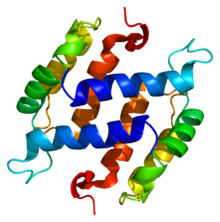S100 단백질
S100 protein| S100/ICABP형 칼슘 결합 도메인 | |||||||||||
|---|---|---|---|---|---|---|---|---|---|---|---|
 S100B 단백질의 구조.PDB 1b4c의 PyMOL 렌더링 기준 | |||||||||||
| 식별자 | |||||||||||
| 기호 | S_100 | ||||||||||
| Pfam | PF01023 | ||||||||||
| 인터프로 | IPR013787 | ||||||||||
| 프로사이트 | PDOC00275 | ||||||||||
| SCOP2 | 1cnp / SCOPe / SUPFAM | ||||||||||
| |||||||||||
S100 단백질은 나선형-루프-헬릭스("EF-hand type") 순응을 갖는 두 개의 칼슘 결합 부위가 특징인 척추동물에서 발견되는 낮은 분자중량 단백질 계열이다.적어도 21개의 다른 S100 단백질이 알려져 있다.[1]그것들은 예를 들어 S100A1, S100A2, S100A3과 같은 S100 접두사를 사용하는 유전자의 한 부류에 의해 암호화된다.그것들은 손상 관련 분자 패턴 분자(DAMP)로도 간주되며, 아릴 탄화수소 수용체의 녹다운은 THP-1 세포에서 S100 단백질의 발현을 하향 조절한다.[2]null
구조
대부분의 S100 단백질은 두 개의 동일한 폴리펩타이드(호모디메릭)로 구성되며, 비동결 결합에 의해 결합된다.그것들은 구조적으로 칼모듈린과 비슷하다.그러나 다른 특징에서는 차모듈린과 다르다.예를 들어, 그들의 표현 패턴은 특정 세포 유형으로 표현되는 세포 고유의 것이다.그들의 표현은 환경적 요인에 따라 달라진다.이와는 대조적으로, Calmodulin은 많은 세포에서 광범위하게 표현되는 유비쿼터스 및 범용 세포내 Ca2+ 수용체다.null
정상 함수
S100 단백질은 보통 신경마루(슈완 세포, 멜라노사이트), 콘드로시테스, 아디프로테스, 근피델리알 세포, 대식세포, 랑게르한스 세포,[3][4] 덴드리트 세포,[5] 각질세포에서 파생된 세포에 존재한다.그들은 어떤 가슴 상피 세포에 있을 수 있다.null
S100 단백질은 단백질 인산화, 전사인자, Ca항원시2+, 세포골격 성분의 역학, 효소 활동, 세포 성장과 분화, 염증 반응 등의 [6]다양한 세포내 및 세포외 기능에 관여되어 왔다.S100A7(psoriasin)과 S100A15는 특히 건선과 같은 자가면역 피부 조건에서 염증에서 사이토카인 역할을 하는 것으로 밝혀졌다.[7]null
병리학
S100 단백질 계열의 여러 구성원은 특정 종양과 표피 분화의 표지로 유용하다.멜라노마,[8] 슈완노마 100%, 신경피브로마 100%(슈완노마보다 약함), 악성 말초신경 피복종양 50%(약하거나 초점일 수 있음), 파라강글리오마 스트롬세포, 히스티오모마, 클리어세포 사르코마 등에서 발견될 수 있다.나아가 S100 단백질은 염증성 질환의 표식이며 염증을 매개하고 항균 작용을 할 수 있다.[9]S100 단백질은 해부학적 병리학 세포 표지로 연구실에서 사용되어 왔다.null
인간유전자
- S100A1, S100A2, S100A3, S100A4, S100A5, S100A6, S100A7 (psoriasin), S100A8 (calgranulin A), S100A9 (calgranulin B), S100A10, S100A11, S100A12 (calgranulin C), S100A13, S100A14, S100A15 (koebnerisin), S100A16
- S100B
- S100P[10][11]
- S100Z(S100Z), CRNN; FLG, FLG2, HRNR, RPTN, S100G, TCHH, THL1
명명법
"S100" 기호 접두사는 이러한 단백질이 100%로 용해된다는 것을 의미한다. 즉, 중성 pH에서 포화상태의 황산암모늄이다.기호는 하이픈으로 연결된 경우가 많으나,[12] 현재 유전자와 단백질 명칭은 HUGO Gene Nomenclature Committee와 같이 기호에 하이픈을 사용하지 않는다.null
참고 항목
참조
- ^ Marenholz I, Heizmann CW, Fritz G (2004). "S100 proteins in mouse and man: from evolution to function and pathology (including an update of the nomenclature)". Biochemical and Biophysical Research Communications. 322 (4): 1111–22. doi:10.1016/j.bbrc.2004.07.096. PMID 15336958.
- ^ Memari B, Bouttier M, Dimitrov V, Ouellette M, Behr MA, Fritz JH, White JH (2015). "Engagement of the Aryl Hydrocarbon Receptor in Mycobacterium tuberculosis-Infected Macrophages Has Pleiotropic Effects on Innate Immune Signaling". Journal of Immunology. 195 (9): 4479–91. doi:10.4049/jimmunol.1501141. PMID 26416282.
- ^ Wilson, AJ; Maddox, PH; Jenkins, D (January 1991). "CD1a and S100 antigen expression in skin Langerhans cells in patients with breast cancer". The Journal of Pathology. 163 (1): 25–30. doi:10.1002/path.1711630106. PMID 2002421. S2CID 70911084.
- ^ Coppola D, Fu L, Nicosia SV, Kounelis S, Jones M (1998). "Prognostic significance of p53, bcl-2, vimentin, and S100 protein-positive Langerhans cells in endometrial carcinoma". Human Pathology. 29 (5): 455–62. doi:10.1016/s0046-8177(98)90060-0. PMID 9596268.
- ^ Shinzato M, Shamoto M, Hosokawa S, Kaneko C, Osada A, Shimizu M, Yoshida A (1995). "Differentiation of Langerhans cells from interdigitating cells using CD1a and S-100 protein antibodies". Biotechnic & Histochemistry. 70 (3): 114–8. doi:10.3109/10520299509108327. PMID 7548432.
- ^ Donato R (2003). "Intracellular and extracellular roles of S100 proteins". Microscopy Research and Technique. 60 (6): 540–51. doi:10.1002/jemt.10296. PMID 12645002. S2CID 37798037.
- ^ Wolf R, Howard OM, Dong HF, Voscopoulos C, Boeshans K, Winston J, Divi R, Gunsior M, Goldsmith P, Ahvazi B, Chavakis T, Oppenheim JJ, Yuspa SH (2008). "Chemotactic activity of S100A7 (Psoriasin) is mediated by the receptor for advanced glycation end products and potentiates inflammation with highly homologous but functionally distinct S100A15". Journal of Immunology. 181 (2): 1499–506. doi:10.4049/jimmunol.181.2.1499. PMC 2435511. PMID 18606705.
- ^ Nonaka D, Chiriboga L, Rubin BP (2008). "Differential expression of S100 protein subtypes in malignant melanoma, and benign and malignant peripheral nerve sheath tumors". Journal of Cutaneous Pathology. 35 (11): 1014–9. doi:10.1111/j.1600-0560.2007.00953.x. PMID 18547346. S2CID 22907221.
- ^ Wolf R, Ruzicka T, Yuspa SH (July 2010). "Novel S100A7 (psoriasin)/S100A15 (koebnerisin) subfamily: highly homologous but distinct in regulation and function". Amino Acids. 41 (4): 789–96. doi:10.1007/s00726-010-0666-4. PMC 6410564. PMID 20596736.
- ^ Penumutchu, Srinivasa R.; Chou, Ruey-Hwang; Yu, Chin (2014-08-01). "Structural Insights into Calcium-Bound S100P and the V Domain of the RAGE Complex". PLOS ONE. 9 (8): e103947. Bibcode:2014PLoSO...9j3947P. doi:10.1371/journal.pone.0103947. ISSN 1932-6203. PMC 4118983. PMID 25084534.
- ^ Penumutchu, Srinivasa R.; Chou, Ruey-Hwang; Yu, Chin (2014-10-17). "Interaction between S100P and the anti-allergy drug cromolyn". Biochemical and Biophysical Research Communications. 454 (3): 404–409. doi:10.1016/j.bbrc.2014.10.048. ISSN 1090-2104. PMID 25450399.
- ^ Elsevier, Dorland's Illustrated Medical Dictionary, Elsevier.
추가 읽기
- Wolf R, Voscopoulos CJ, FitzGerald PC, Goldsmith P, Cataisson C, Gunsior M, Walz M, Ruzicka T, Yuspa SH (2006). "The mouse S100A15 ortholog parallels genomic organization, structure, gene expression, and protein-processing pattern of the human S100A7/A15 subfamily during epidermal maturation". The Journal of Investigative Dermatology. 126 (7): 1600–8. doi:10.1038/sj.jid.5700210. PMID 16528363.
- Wolf R, Howard OM, Dong HF, Voscopoulos C, Boeshans K, Winston J, Divi R, Gunsior M, Goldsmith P, Ahvazi B, Chavakis T, Oppenheim JJ, Yuspa SH (2008). "Chemotactic activity of S100A7 (Psoriasin) is mediated by the receptor for advanced glycation end products and potentiates inflammation with highly homologous but functionally distinct S100A15". Journal of Immunology. 181 (2): 1499–506. doi:10.4049/jimmunol.181.2.1499. PMC 2435511. PMID 18606705.
- Wolf R, Voscopoulos C, Winston J, Dharamsi A, Goldsmith P, Gunsior M, Vonderhaar BK, Olson M, Watson PH, Yuspa SH (2009). "Highly homologous hS100A15 and hS100A7 proteins are distinctly expressed in normal breast tissue and breast cancer". Cancer Letters. 277 (1): 101–7. doi:10.1016/j.canlet.2008.11.032. PMC 2680177. PMID 19136201.
- Wolf R, Mascia F, Dharamsi A, Howard OM, Cataisson C, Bliskovski V, Winston J, Feigenbaum L, Lichti U, Ruzicka T, Chavakis T, Yuspa SH (2010). "Gene from a psoriasis susceptibility locus primes the skin for inflammation". Science Translational Medicine. 2 (61): 61ra90. doi:10.1126/scitranslmed.3001108. PMC 6334290. PMID 21148126.



